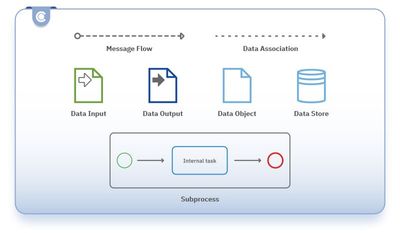Modeling data in the context of BPMN: the basics
Written by Andrea
23 January 2024 · 6 min read

Organizations rely heavily on efficient processes and accurate data analysis. BPMN, a widely-used modeling standard, plays a key role in visualizing business processes, while data modeling ensures that the information flowing through these processes is well-organized and meaningful.
In the following sections, we define what data modeling is in the context of BPMN. We also present the elements BPMN provides for modeling data and the types of data models commonly used in BPMN.
Data modeling in BPMN
When it comes to BPMN, data modeling refers to the process of defining and representing data elements and their relationships within a business process.
BPMN is a graphical notation for modeling and documenting business processes. And it’s particularly useful for illustrating the flow of activities and interactions between participants. However, BPMN alone doesn’t provide a comprehensive way to model the data a process manipulates, produces, or consumes. Nevertheless, data is a key component that not only supports the business itself but also its Business Intelligence (BI) operations. This is where data modeling comes into play.
Data modeling in BPMN involves identifying the data elements or objects used and produced during the process execution. The data involved in the process is either persistent (the data that remains beyond the life cycle or the scope of the process) or not persistent (volatile).
Simply put, data modeling can help business analysts understand how data flows through their processes. It’s essential for optimizing business processes, identifying bottlenecks, and ensuring that the correct information is available at the right workflow stages. It also aids in developing business applications and systems that support the main business processes.
Main BPMN elements for modeling data
Typically, data modeling in BPMN includes the use of the following elements:
- Data Objects - these can represent different types of data in a business process. They can be physical items (for example, products or documents) or information (for example, order numbers or customer details) that are created, modified, stored, or passed along within the business process. Each Data Object has attributes such as name and type, providing detailed information about the data it represents.
- Data Input - this element specifies the information an activity or a process needs to execute.
- Data Output - this element represents the information an activity or a process produces upon completion.
- Data Associations - these show the relationship between activities and Data Objects and indicate how data flows between different process elements. For instance, a Data Association shows how data comes and goes from activities or events within a pool.
- Data Stores - these represent repositories or databases where process information is stored. They’re usually used in Subprocesses or to indicate where data is persisted, retrieved, or updated during the execution of a process. A data store can represent paper documents (for example, an agenda or a notebook) or an electronic database.
- Message Flows - these BPMN elements show the flow of messages (which can carry data) between different pools or participants in a process. For example, a message such as an email or a phone call crosses the pool boundary to show the interactions between separate private business processes.

By incorporating the above elements and their relationships into the BPMN diagrams, business analysts can effectively model the data aspects of their processes. Consequently, they can create comprehensive process models that describe the sequence of activities and the data dependencies and interactions within the processes.
Types of data models used in BPMN
In the context of BPMN, business analysts can use different types of data models to represent various aspects of data within a specific process. Each type serves a different purpose and helps to document, analyze, and optimize the data aspects of a process before modeling the process in BPMN. The choice of the appropriate data model depends on the specific requirements of the process and the nature of the represented data.
Class diagrams
Class diagrams are data models that illustrate the structure of data in terms of classes, their attributes, associations, and operations. Classes represent different types of data objects used within the process. Each class corresponds to a specific data entity, such as a product, customer, or invoice. Associations represent relationships between different classes - for example, the relationship between class “Order” and class “Customer” indicates the association of an order with a specific customer. Attributes define the properties or data fields of a class. And operations represent the actions or behaviors performed on the data objects.
Data Flow diagrams
Data Flow diagrams (DFD) illustrate the flow and transformation of data within a system and help improve the understanding of the data aspects of a business process. They can show how data objects move between activities, data stores, processes, and external entities in a business process. Processes in DFD represent activities and transformations that occur within the system and are analogous to the Activities in a business process. External entities are destinations or sources of data outside the system - for example, participants or entities interacting with the business process from the outside.
Entity-relationship diagrams
Entity-relationship diagrams (ERD) visualize the relationships between different entities (things) in a database. Business analysts can use them to model how different data objects relate to each other within a specific business process. There are two types of entities in an ERD: tangible (for example, customers) and intangible (for example, a purchase). And each entity has attributes that present specific facts about it, such as name and description.
Data mapping tables
Data mapping tables are also known as data transformation tables or mapping documents. These are documents or spreadsheets that provide a clear and structured way to map data elements and their relationships from one format to another. Business analysts can use them to specify how data objects in a business process map to fields or attributes in databases, APIs, or other systems. Data mapping tables are scalable and can handle complex data integration scenarios. They’re adaptable to different data structures and can accommodate changes in business requirements. They also help maintain data integrity during integration processes, ensuring the accurate transformation and interpretation of data and minimizing the risk of data errors.
UML sequence diagrams
UML sequence diagrams help illustrate the sequence of data exchanges and interactions between different process elements over time. A UML sequence diagram contains lifelines, messages, activation bars, and combined fragments. The diagram can also include notes providing explanations, annotations, or additional information about specific interactions or elements within the sequence. These diagrams help validate and test the business process by simulating different scenarios and data exchanges. They also serve as valuable documentation for the BPMN process and help ensure effective stakeholder communication.
Message models
Message models specify the format and content of messages sent and received during process execution, particularly in inter-process communication scenarios. They describe the data elements, types, and relationships within a message. These models are typically represented using standard languages or notations such as XML schema, JSON schema, or protocol buffers. Message models help maintain data consistency and ensure interoperability and seamless communication between business processes and external systems or services. Developers can use these models as guidelines to implement message-handling logic, ensuring accurate data processing.
Data dictionaries
Data dictionaries represent centralized repositories of data information and consist of the following elements: data elements, attributes, data types, allowable values, relationships, source of origin, and context of use. They help ensure that everyone participating in the BPMN process understands the meaning and usage of data elements. They eliminate confusion and misinterpretation and improve communication among stakeholders. Data dictionaries also help validate incoming data to ensure it adheres to predefined standards, preventing errors and inconsistencies in the BPMN process.
XML schemas
XML schemas define the structure and constraints of XML documents. They’re useful for specifying the format and content of data objects exchanged between different elements of a business process, especially in cases involving web services. Using XML schemas helps ensure interoperability and consistency when integrating BPMN processes with other systems. XML schemas can be versioned to handle changes in data structures over time. In this regard, when BPMN processes evolve and data requirements change, versioned XML schemas allow for backward and forward compatibility. They ensure smooth transitions and minimal disruptions during system updates.
In conclusion
Data modeling within the BPMN framework is a powerful tool for organizations wanting to optimize their business processes. BPMN provides essential elements for data modeling, offering a standardized way to represent complex processes and the associated data. And there are various data models business analysts can use to structure and understand their data in a meaningful way.
Further reading
Business analysis: The importance of data modeling
IT industry: How to cut IT development costs


Andrea is the collective pseudonym for the group of people working behind Cardanit, the Business Process Management Software as a Service of ESTECO. The group has different backgrounds and several decades of experience in fields varying from BPM, BPMN, DMN, Process Mining, Simulation, Optimization, Numerical Methods, Research and Development, and Marketing.
Andrea is the collective pseudonym for the group of people working behind Cardanit, the Business Process Management Software as a Service of ESTECO. The group has different backgrounds and several decades of experience in fields varying from BPM, BPMN, DMN, Process Mining, Simulation, Optimization, Numerical Methods, Research and Development, and Marketing.
Learn how to effectively represent data in your BPMN diagrams, create reliable data models and design processes that align with your organizational goals.
Do you know how to model data in BPMN?
Learn how to effectively represent data in your BPMN diagrams, create reliable data models and design processes that align with your organizational goals.
Do you know how to model data in BPMN?
Learn how to effectively represent data in your BPMN diagrams, create reliable data models and design processes that align with your organizational goals.
